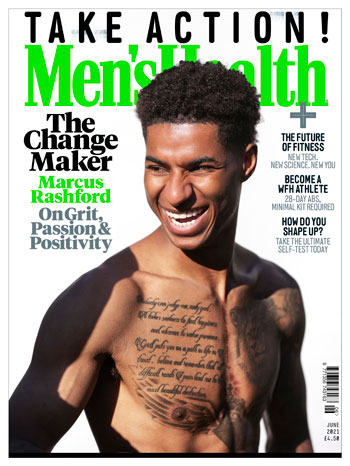
Q: What were the main challenges facing your health brands at the start of the pandemic?
A:
Initially, I think like for many businesses, there was some uncertainty on how the transition to working from home would go, but I have to say it was a fairly seamless process for us – we were set up well for flexible working. The pandemic challenged us to be creative on our shoots, with some brands working with cover stars to self-shoot, and several liaising with our international teams on content when shoots weren’t possible due to restrictions.The world of digital got even faster, and our brands were challenged to remain relevant in an ever-changing news world. There was a huge demand for content around home workouts, mental wellness, the best fitness equipment to buy and what to cook during lockdown – our editorial teams had a massive task on their hands to satisfy this demand, which they did expertly.
We faced a challenge on our events too. In the case of Women’s Health Live – traditionally our biggest physical event with 8,000 paying customers – we had to pivot to a virtual format within just three weeks. Global stars like Jillian Michaels and Davina McCall were asked to shoot content from home, whilst panels and wellness sessions were streamed across Women’s Health digital channels, with around 11m video views the result. Six weeks after our first Women’s Health Live Virtual event, we had a second, which was supported by headline sponsor Tetley Cold Infusions.
Q: What have been the key learnings from the rise of home workouts and virtual events?
A:
First and foremost, we’ve learned that the demand is there – around 20,000 people were taking part in Men’s Health’s home workouts on Instagram, daily. It’s interesting to note that a recent Men’s Health poll showed 51% still plan on incorporating home workouts into fitness routines post lockdown, so we know there’s still appetite.
It also hit home that virtual workouts and events allow us to engage with consumers across the world – we saw people tuning in from America to India and Germany to Australia. The virtual format gave us access to stars across the world, including the likes of Mat Fraser, the world’s fittest man.
There were new challenges on virtual events. We had to find the best hosting platform partners, build a different premium consumer experience and ultimately create unique propositions for commercial partners. For example, with our Men’s Health and Women’s Health Weekenders events in January, we created a virtual Marketplace that allowed 35 health and wellness brands to exhibit their latest products.
There’s no question that virtual doesn’t have the magic of a physical event, but the pandemic has taught us that a hybrid model will be the way forward for most events. We’ve learnt invaluable ways of engaging audiences with functions like live chats, or in some cases gift sets that allow them to take part at home. Of course, things like gala dinners and other social gatherings simply can’t be recreated through virtual.
Q: E-commerce has grown hugely during lockdown - how did your health brands go about tapping into that and what has worked particularly well for you?
A:
E-commerce has been a significant part of our strategy for several years, but in 2020, we saw a seismic shift in success. The numbers are quite crazy when you look at them: Men’s Health grew by 454%, Runner’s World by 341% and Women’s Health saw a rise of over 500% in revenue generated through e-commerce.When we went into lockdown, there was an instant scramble for the best massage guns, running shoes and yoga mats, whilst finding dumbbells quickly became an art. Our dedicated shopping teams, along with editorial talent – who have been trained on e-commerce – worked tirelessly to drive product review content to sit alongside purchase options. The authority of our brands continues to play a huge role in consumer purchase decisions, whilst another factor has been the scale of traffic to online channels. Our wellness brands saw web traffic increases between 35-58% last year, and Men’s Health peaked at 5m unique users in May.
Q: How has your video strategy and performance evolved over the past eighteen months and what have been the key learnings?
A:
Video has been a standout success for us over the last year and a half. To give some form of context, we’ve seen Women’s Health’s YouTube subscribers increase by more than 350%, whilst Men’s Health gained a gigantic 600% rise in revenue generated through YouTube.I think what’s clear from the pandemic is that video – and social media – are ideally placed to recreate the kind of environment that otherwise could only be supplied by a club or live event. We provided content that people craved at the time, and still do. A great example of this is Men’s Health’s ‘How I Build My Body’ franchise which has welcomed stars such as Ashley Walters and Patrick Hutchinson. YouTube and video have also been a major focus in our wellness events, helping to attract new subscribers.
Q: Many media brands have seen increases in subscriber numbers during the pandemic; how has your subscription strategy changed over this period?
A:
Whilst the pandemic has presented an undeniable challenge for magazines on newsstand, we’re incredibly pleased with the success we’ve had with subscribers. We reacted quickly to the changing market conditions and customer behaviour by focussing our messaging on getting to the heart of the needs of our audience. This resulted in not only an increase in acquisitions but also a higher take up of longer-term subscriptions. Overall, in 2020, revenue generated from subscriptions of our health and wellness brands, rose by 27% year-on-year.Q: Branded partnerships is a growing revenue stream for many publishers. How has your branded partnership offering developed since the start of lockdown?
A:
We often talk about the trust consumers place in our brands, but commercially, this has also been extremely evident. Last year, across Hearst UK, branded partnerships were up 12% which, given the climate, was an astounding achievement. We’re now on course for a 100%+ increase for the first half of 2021.
The Hearst UK panel has been a crucial component to branded partnerships. The panel allows external brands to gain an insight into their target consumer’s habits, before working with our teams to build campaigns that will generate maximum impact. We’ve also used social listening and emotional intelligence, which allows us to delve deeper into consumer perceptions of brands, enabling us to understand the impact a campaign has on sentiment and perception.
Arguably the biggest success we’ve had here is with Philips, who are a long-term partner of our Project Body Love campaign. The campaign – which features a huge editorial calendar, virtual events and an augmented reality project – is geared towards increasing female body confidence, as well as boosting Philips’ image as a hair removal brand. To date, the campaign has helped a 43% increase in women’s body confidence, whilst Philips’ preference rating as a women’s hair removal brand has gone up 10%.
Q: In your experience, what are the key dos and don'ts of successful brand partnerships?
A:
Data is essential for all partnerships, both in formulating the idea and also monitoring the results. Our best campaigns have seen us gather bigger teams who unpick all of our data points, adding huge amounts of emotive and human value. I’d also think hard about how you can push ideas into new and untapped territories, and how campaigns can drive an emotional connection between brand and consumer. Motivate them, inspire them, move them.On the flip side, don’t lose sight of the consumer journey – partnerships are designed to take consumers on a journey. Ensure a strategy is in place that will be effective in hitting all KPIs and moving consumers through the all-important purchase funnel. And, most certainly, don’t go without an effectiveness study to help everyone learn and improve. We always recommend pre, mid and post campaign studies.
Q: Where next for your health brands?
A:
Our business strategy focuses around three key areas: growing our print share, digital acceleration and revenue diversification. If we consider our health and wellness brands, the overarching aim is to enhance our role as the authority of all things physical and mental health, and to help consumers get the very best out of their lives. That can be through inspiring print and digital content, events, partnerships and licensing. A major focus for us this year will be the introduction of memberships, which will offer consumers some of the very best exclusive content, expert advice and benefits relating to their physical and mental health. More on that soon!This article was published in the InPubWeekly newsletter. To be added to the mailing list, enter your email address here.










